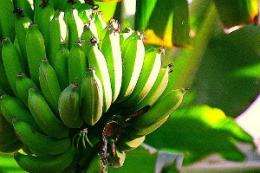Banana crop abundance linked to length of day

New research has found bananas are photoperiod responsive, overruling the widely accepted belief that temperature is the key variable in banana development.
Seasonal variation in banana production is an issue for growers worldwide, and has driven research focused on what influences the plant’s rate of development and flowering.
The UWA – Chiquita Brands study has found that longer photoperiods—the time from sunrise to sunset—during the reproductive phase, are correlated with an increased rate of bunch appearance at the top of the pseudostem 8-10 weeks later.
Long photoperiods during the mid-vegetative stage hasten flowering, and the 2–3 months before formation of the bunch are most important for photoperiod.
This information is expected to help growers develop better planting timetables to ensure consistent fruit production.
Recently published in CSIRO’s Functional Plant Biology, the study, ‘Evidence that banana (Musa spp.), a tropical monocotyledon, has a facultative long-day response to photoperiod,’ collated data from four major research projects from around the world.
Data from Puerto Rico, Ivory Coast, New South Wales and South Africa were analysed and the sensitivity of the plants to photoperiod in each location were calculated.
The juvenile phase, the mid-vegetative phase, and the flowering phase were studied closely in relation to photoperiod, temperature, soil conditions and overall growth pattern to find what minimised the variation in flowering.
Co-Author and UWA Honorary Research Fellow David Turner says the effects of photoperiod on bananas had not been fully explored before now.
“Originally we thought the development of bananas wouldn’t be responsive to photoperiod but there’s some literature that says temperature isn’t the only thing that explains it,” Prof Turner says.
“Once we got into the numbers we were surprised that the message seemed to be so clear across all locations.
“We had several data sets—we were able to calculate what happened in one and then use those numbers to predict what was happening somewhere else.”
Prof Turner says this information gives plant breeders potential to breed banana crops that are either more or less sensitive to photoperiod.
There is debate whether it is the length of day or the amount of sunshine that is important in photoperiod.
The rate of change of sunrise and sunset and the photoperiod’s effect on plants in the fruit- bearing stage will be studied further.
An experiment initiated in the Canary Islands using artificial light to prolong the photoperiod will test its affects on banana crops in the next year.
Provided by ScienceNetwork Western Australia


















